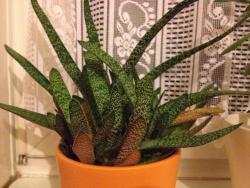Hello all!
I'm new to the forum, nice to meet you.

I'm looking for a little advice with my gasteria.
I over-watered the plant once thinking it would be hot and the soil would dry up quickly, as it usually does. As a result (I think) one of the larger leaves had yellowed and never restored, although it's still growing back green at the base. I was wondering if it's safe to cut most of the dried leaf off, since it's half-dead and useless? Would the gasteria take that well? My aloe's leaves occasionally tend to start drying from the tip of a cut, so I'm not sure.
Additionally I was wondering about the random browning leaves within the smaller clusters. I *guess* it might be due to direct sunlight (judging by how some leaves are only partially brown... as though burnt only in places where they aren't shadowed by other leaves)... BUT that doesn't explain why those are mostly lower leaves, while the upper/outermost ones, the ones most exposed to sunlight, are perfectly green


The gasteria is potted in standard soil with drainage, I keep it on a southern windowsill most of the year and sheltered behind curtains in the summer. I water my succulents whenever the soil has been properly dry for some time, which depends on the weather.
Thanks for any advice!



